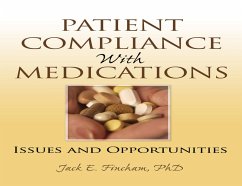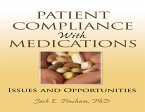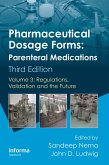Richard Schulz, Christopher Cook, Louis Roller, Jack Fincham, Jenny Gowan
Patient Compliance with Medications (eBook, ePUB)
Issues and Opportunities
29,95 €
29,95 €
inkl. MwSt.
Sofort per Download lieferbar

15 °P sammeln
29,95 €
Als Download kaufen

29,95 €
inkl. MwSt.
Sofort per Download lieferbar

15 °P sammeln
Jetzt verschenken
Alle Infos zum eBook verschenken
29,95 €
inkl. MwSt.
Sofort per Download lieferbar
Alle Infos zum eBook verschenken

15 °P sammeln
Richard Schulz, Christopher Cook, Louis Roller, Jack Fincham, Jenny Gowan
Patient Compliance with Medications (eBook, ePUB)
Issues and Opportunities
- Format: ePub
- Merkliste
- Auf die Merkliste
- Bewerten Bewerten
- Teilen
- Produkt teilen
- Produkterinnerung
- Produkterinnerung

Bitte loggen Sie sich zunächst in Ihr Kundenkonto ein oder registrieren Sie sich bei
bücher.de, um das eBook-Abo tolino select nutzen zu können.
Hier können Sie sich einloggen
Hier können Sie sich einloggen
Sie sind bereits eingeloggt. Klicken Sie auf 2. tolino select Abo, um fortzufahren.

Bitte loggen Sie sich zunächst in Ihr Kundenkonto ein oder registrieren Sie sich bei bücher.de, um das eBook-Abo tolino select nutzen zu können.
Improve your patient's health through a fresh view of their behaviors
Patients who use over-the-counter (OTC) and prescription medicine often do not take the drugs as intended, sometimes to the detriment to their health and well-being. These widespread problems cause health professionals to agonize over how to try to make sure pati
- Geräte: eReader
- mit Kopierschutz
- eBook Hilfe
Andere Kunden interessierten sich auch für
![Patient Compliance with Medications (eBook, PDF) Patient Compliance with Medications (eBook, PDF)]() Richard SchulzPatient Compliance with Medications (eBook, PDF)29,95 €
Richard SchulzPatient Compliance with Medications (eBook, PDF)29,95 €![Nanoparticulate Drug Delivery Systems (eBook, ePUB) Nanoparticulate Drug Delivery Systems (eBook, ePUB)]() Nanoparticulate Drug Delivery Systems (eBook, ePUB)61,95 €
Nanoparticulate Drug Delivery Systems (eBook, ePUB)61,95 €![Pharmaceutical Dosage Forms - Parenteral Medications (eBook, ePUB) Pharmaceutical Dosage Forms - Parenteral Medications (eBook, ePUB)]() Pharmaceutical Dosage Forms - Parenteral Medications (eBook, ePUB)186,95 €
Pharmaceutical Dosage Forms - Parenteral Medications (eBook, ePUB)186,95 €![A Guide to Particulate Science in Pharmaceutical Product Development (eBook, ePUB) A Guide to Particulate Science in Pharmaceutical Product Development (eBook, ePUB)]() Margaret D. LoueyA Guide to Particulate Science in Pharmaceutical Product Development (eBook, ePUB)157,95 €
Margaret D. LoueyA Guide to Particulate Science in Pharmaceutical Product Development (eBook, ePUB)157,95 €![Compliance Handbook for Pharmaceuticals, Medical Devices, and Biologics (eBook, ePUB) Compliance Handbook for Pharmaceuticals, Medical Devices, and Biologics (eBook, ePUB)]() Compliance Handbook for Pharmaceuticals, Medical Devices, and Biologics (eBook, ePUB)63,95 €
Compliance Handbook for Pharmaceuticals, Medical Devices, and Biologics (eBook, ePUB)63,95 €![Pharmaceutical Dosage Forms - Parenteral Medications (eBook, ePUB) Pharmaceutical Dosage Forms - Parenteral Medications (eBook, ePUB)]() Pharmaceutical Dosage Forms - Parenteral Medications (eBook, ePUB)45,95 €
Pharmaceutical Dosage Forms - Parenteral Medications (eBook, ePUB)45,95 €![Testing Computers Systems for FDA/MHRA Compliance (eBook, ePUB) Testing Computers Systems for FDA/MHRA Compliance (eBook, ePUB)]() David StokesTesting Computers Systems for FDA/MHRA Compliance (eBook, ePUB)157,95 €
David StokesTesting Computers Systems for FDA/MHRA Compliance (eBook, ePUB)157,95 €-
-
-
Improve your patient's health through a fresh view of their behaviors
Patients who use over-the-counter (OTC) and prescription medicine often do not take the drugs as intended, sometimes to the detriment to their health and well-being. These widespread problems cause health professionals to agonize over how to try to make sure pati
Patients who use over-the-counter (OTC) and prescription medicine often do not take the drugs as intended, sometimes to the detriment to their health and well-being. These widespread problems cause health professionals to agonize over how to try to make sure pati
Dieser Download kann aus rechtlichen Gründen nur mit Rechnungsadresse in A, B, BG, CY, CZ, D, DK, EW, E, FIN, F, GR, HR, H, IRL, I, LT, L, LR, M, NL, PL, P, R, S, SLO, SK ausgeliefert werden.
Produktdetails
- Produktdetails
- Verlag: Taylor & Francis eBooks
- Seitenzahl: 250
- Erscheinungstermin: 15. April 2020
- Englisch
- ISBN-13: 9781000083224
- Artikelnr.: 59236803
- Verlag: Taylor & Francis eBooks
- Seitenzahl: 250
- Erscheinungstermin: 15. April 2020
- Englisch
- ISBN-13: 9781000083224
- Artikelnr.: 59236803
- Herstellerkennzeichnung Die Herstellerinformationen sind derzeit nicht verfügbar.
Dr. Jack E. Fincham is a graduate of the University of Nebraska College of Pharmacy and was a Kellogg Pharmaceutical Clinical Scientist Fellow at the University of Minnesota where he obtained his PhD in Social and Administrative Pharmacy. Dr. Fincham has completed a Post Graduate Certificate Degree in Health Economics at the University of Aberdeen, Scotland. Dr. Fincham has held academic, research, and administrative positions at several Schools and Colleges of Pharmacy. He has researched varying topics pertaining to patient compliance, medication management, the Medicare drug benefit, smoking cessation, and health economics. Dr. Fincham currently serves as the A. W. Jowdy Professor of Pharmacy Care at the UGA College of Pharmacy and Professor of Public Health in the UGA College of Public Health. He is a member of the University of Georgia Teaching Academy. From 1994 to 2004, Dr. Fincham served as dean of the University of Kansas School of Pharmacy. Dr. Fincham has authored over 200 refereed and professional manuscripts published in sixty journals. He has made over 200 professional and research presentations to allied health, dental, medical, information technology, nursing, nutrition, pharmacy, and public health professional groups from Vietnam, China, Asia, Australia, Canada, Europe, the United Kingdom, and the United States. He has edited and written ten books. Dr. Fincham is the founding editor of the Journal of Public Health Pharmacy and serves as the associate editor of the American Journal of Pharmaceutical Education. Dr. Fincham authored Taking Your Medicine: A Guide to Medication Regimens and Compliance for Patients and Caregivers, published by The Haworth Press (www.takingyourmedicine.com). This book has been listed as one of the "Best consumer health books of 2005" by Library Journal. He has recently completed the book: The Medicare Part D Program: Making the Most of the Benefit, published by Jones & Bartlett Publishers. Dr. Fincham is an active member of numerous pharmacy, public health, and academic associations. He currently serves as a member of the Nonprescription Drug Advisory Committee of the U.S. Food and Drug Administration and has served as an advisor for the CMS Medicare Drug Benefit Program from 2003 until 2007. Dr. Fincham is a Fellow in the American Society of Consultant Pharmacists, a member of Phi Beta Delta Honor Society for International Scholars, Phi Kappa Phi Honor Society, the Rho Chi Pharmaceutical Honor Society, and the Phi Lambda Sigma Pharmacy Leadership Society. In 1997, he was named the recipient of the Faculty Excellence in Pharmacy Administration Award by the National Community Pharmacists Association. Also in 1997, he was given the Dean's Award for Sustained Contributions to Community Pharmacy Practice by the American College of Apothecaries. In 1998, he was listed as one of the top fifty most influential pharmacists in the United States by Drug Topics magazine.
About the Author
Contributors
Chapter 1. Introduction
Chapter 2. Scope of Noncompliance and Other Issues
Drugs, Pharmacists, and Insurance
Self
care
Self
medication
Patient Compliance Issues
Noncompliance As an Alternative
The Consequences of Noncompliance
Factors Affecting Compliance
Dosing
Devices to Aid Patient Compliance
Communication
Manufacturers
Summary
Chapter 3. Drug Therapies Leading to Noncompliant Activity
Jayashri Sankaranarayanan
Introduction
Medication Adherence or Compliance: Definitions, Estimates, Measurement, and Interventions
Theoretical Aspects
Structure and Demand of Drug Therapies
Medical
condition
related Factors
Medication
therapy
related Factors
Patient
related Factors
Health Professional Attributes and Health System Factors
Conclusions and Future Directions
Chapter 4. The Costs of Noncompliance
Introduction
Asthma
Cardiovascular and Cerebrovascular Disease
Diabetes
Infectious Disease
Seizures
The Elderly
Antipsychotic Therapy
Transplantation Pharmacotherapy
Chapter 5. Definitions and Measurement of Compliance
Definitions of Compliance
Noncompliance: Negative Connotations
Measurement of Compliance
Methods to Detect Compliance
Physicians' Estimates of Their Patients' Compliance 85 Can Physicians Be Noncompliant?
Chapter 6. Models to Evaluate Patient Compliance
Christopher Cook Health Belief Model
Theory of Reasoned Action
Theory of Planned Behavior
Social Cognitive Theory
Transtheoretical Model
Other Models
Conclusions
Chapter 7. Methods to Impact Patient Compliance
Types of Impacts on Compliance
Specific Ways to Improve Compliance
Getting into the Habit of Complying
Other Considerations
Summary
Chapter 8. Bridging the Gap Between Provider and Patient Variables: Concordance
The Concordance Movement in Concept and Action
Concordance
Chapter 9. Ethics of Compliance
Capital Punishment and Assisted Suicide
Noncompliance As a Patient Prerogative
Health Insurance Portability and Accountability (HIPPA) Act and Impacts Upon Compliance
Information Technology
Questionable, If Not, Unethical Practices
Pharmaceutical Company Research and Clinical Trials
Chapter 10. The Role of Health Professionals in Influencing Patient Compliance
Richard Schulz
Recognize Limitations and Biases
Make Sense of the Vast and Contradictory Literature
Commitment to the Development of Best Practices Regarding Medication Adherence
Recent Trends in Compliance Research
Summary
Chapter 11. Disease State Management in Older Persons with Hyperlipidemia
Louis Roller, Jenny Gowan
Lipid
lowering Agents
Adherence to Lipid
lowering Therapy
Scenario
Identification of Drug Therapy Problems
Possible Changes in Therapy and Benefits/Problems
Possible Changes in Therapy
Chapter 12. Current and Future Considerations
Achieving Perfection?
Complicated Considerations
Physician and Drug Effects
Questions (Important Factors) to Consider
Future Considerations with Emerging Drug Therapies
Where Do We Go from Here?
Index.
Contributors
Chapter 1. Introduction
Chapter 2. Scope of Noncompliance and Other Issues
Drugs, Pharmacists, and Insurance
Self
care
Self
medication
Patient Compliance Issues
Noncompliance As an Alternative
The Consequences of Noncompliance
Factors Affecting Compliance
Dosing
Devices to Aid Patient Compliance
Communication
Manufacturers
Summary
Chapter 3. Drug Therapies Leading to Noncompliant Activity
Jayashri Sankaranarayanan
Introduction
Medication Adherence or Compliance: Definitions, Estimates, Measurement, and Interventions
Theoretical Aspects
Structure and Demand of Drug Therapies
Medical
condition
related Factors
Medication
therapy
related Factors
Patient
related Factors
Health Professional Attributes and Health System Factors
Conclusions and Future Directions
Chapter 4. The Costs of Noncompliance
Introduction
Asthma
Cardiovascular and Cerebrovascular Disease
Diabetes
Infectious Disease
Seizures
The Elderly
Antipsychotic Therapy
Transplantation Pharmacotherapy
Chapter 5. Definitions and Measurement of Compliance
Definitions of Compliance
Noncompliance: Negative Connotations
Measurement of Compliance
Methods to Detect Compliance
Physicians' Estimates of Their Patients' Compliance 85 Can Physicians Be Noncompliant?
Chapter 6. Models to Evaluate Patient Compliance
Christopher Cook Health Belief Model
Theory of Reasoned Action
Theory of Planned Behavior
Social Cognitive Theory
Transtheoretical Model
Other Models
Conclusions
Chapter 7. Methods to Impact Patient Compliance
Types of Impacts on Compliance
Specific Ways to Improve Compliance
Getting into the Habit of Complying
Other Considerations
Summary
Chapter 8. Bridging the Gap Between Provider and Patient Variables: Concordance
The Concordance Movement in Concept and Action
Concordance
Chapter 9. Ethics of Compliance
Capital Punishment and Assisted Suicide
Noncompliance As a Patient Prerogative
Health Insurance Portability and Accountability (HIPPA) Act and Impacts Upon Compliance
Information Technology
Questionable, If Not, Unethical Practices
Pharmaceutical Company Research and Clinical Trials
Chapter 10. The Role of Health Professionals in Influencing Patient Compliance
Richard Schulz
Recognize Limitations and Biases
Make Sense of the Vast and Contradictory Literature
Commitment to the Development of Best Practices Regarding Medication Adherence
Recent Trends in Compliance Research
Summary
Chapter 11. Disease State Management in Older Persons with Hyperlipidemia
Louis Roller, Jenny Gowan
Lipid
lowering Agents
Adherence to Lipid
lowering Therapy
Scenario
Identification of Drug Therapy Problems
Possible Changes in Therapy and Benefits/Problems
Possible Changes in Therapy
Chapter 12. Current and Future Considerations
Achieving Perfection?
Complicated Considerations
Physician and Drug Effects
Questions (Important Factors) to Consider
Future Considerations with Emerging Drug Therapies
Where Do We Go from Here?
Index.
About the Author
Contributors
Chapter 1. Introduction
Chapter 2. Scope of Noncompliance and Other Issues
Drugs, Pharmacists, and Insurance
Self
care
Self
medication
Patient Compliance Issues
Noncompliance As an Alternative
The Consequences of Noncompliance
Factors Affecting Compliance
Dosing
Devices to Aid Patient Compliance
Communication
Manufacturers
Summary
Chapter 3. Drug Therapies Leading to Noncompliant Activity
Jayashri Sankaranarayanan
Introduction
Medication Adherence or Compliance: Definitions, Estimates, Measurement, and Interventions
Theoretical Aspects
Structure and Demand of Drug Therapies
Medical
condition
related Factors
Medication
therapy
related Factors
Patient
related Factors
Health Professional Attributes and Health System Factors
Conclusions and Future Directions
Chapter 4. The Costs of Noncompliance
Introduction
Asthma
Cardiovascular and Cerebrovascular Disease
Diabetes
Infectious Disease
Seizures
The Elderly
Antipsychotic Therapy
Transplantation Pharmacotherapy
Chapter 5. Definitions and Measurement of Compliance
Definitions of Compliance
Noncompliance: Negative Connotations
Measurement of Compliance
Methods to Detect Compliance
Physicians' Estimates of Their Patients' Compliance 85 Can Physicians Be Noncompliant?
Chapter 6. Models to Evaluate Patient Compliance
Christopher Cook Health Belief Model
Theory of Reasoned Action
Theory of Planned Behavior
Social Cognitive Theory
Transtheoretical Model
Other Models
Conclusions
Chapter 7. Methods to Impact Patient Compliance
Types of Impacts on Compliance
Specific Ways to Improve Compliance
Getting into the Habit of Complying
Other Considerations
Summary
Chapter 8. Bridging the Gap Between Provider and Patient Variables: Concordance
The Concordance Movement in Concept and Action
Concordance
Chapter 9. Ethics of Compliance
Capital Punishment and Assisted Suicide
Noncompliance As a Patient Prerogative
Health Insurance Portability and Accountability (HIPPA) Act and Impacts Upon Compliance
Information Technology
Questionable, If Not, Unethical Practices
Pharmaceutical Company Research and Clinical Trials
Chapter 10. The Role of Health Professionals in Influencing Patient Compliance
Richard Schulz
Recognize Limitations and Biases
Make Sense of the Vast and Contradictory Literature
Commitment to the Development of Best Practices Regarding Medication Adherence
Recent Trends in Compliance Research
Summary
Chapter 11. Disease State Management in Older Persons with Hyperlipidemia
Louis Roller, Jenny Gowan
Lipid
lowering Agents
Adherence to Lipid
lowering Therapy
Scenario
Identification of Drug Therapy Problems
Possible Changes in Therapy and Benefits/Problems
Possible Changes in Therapy
Chapter 12. Current and Future Considerations
Achieving Perfection?
Complicated Considerations
Physician and Drug Effects
Questions (Important Factors) to Consider
Future Considerations with Emerging Drug Therapies
Where Do We Go from Here?
Index.
Contributors
Chapter 1. Introduction
Chapter 2. Scope of Noncompliance and Other Issues
Drugs, Pharmacists, and Insurance
Self
care
Self
medication
Patient Compliance Issues
Noncompliance As an Alternative
The Consequences of Noncompliance
Factors Affecting Compliance
Dosing
Devices to Aid Patient Compliance
Communication
Manufacturers
Summary
Chapter 3. Drug Therapies Leading to Noncompliant Activity
Jayashri Sankaranarayanan
Introduction
Medication Adherence or Compliance: Definitions, Estimates, Measurement, and Interventions
Theoretical Aspects
Structure and Demand of Drug Therapies
Medical
condition
related Factors
Medication
therapy
related Factors
Patient
related Factors
Health Professional Attributes and Health System Factors
Conclusions and Future Directions
Chapter 4. The Costs of Noncompliance
Introduction
Asthma
Cardiovascular and Cerebrovascular Disease
Diabetes
Infectious Disease
Seizures
The Elderly
Antipsychotic Therapy
Transplantation Pharmacotherapy
Chapter 5. Definitions and Measurement of Compliance
Definitions of Compliance
Noncompliance: Negative Connotations
Measurement of Compliance
Methods to Detect Compliance
Physicians' Estimates of Their Patients' Compliance 85 Can Physicians Be Noncompliant?
Chapter 6. Models to Evaluate Patient Compliance
Christopher Cook Health Belief Model
Theory of Reasoned Action
Theory of Planned Behavior
Social Cognitive Theory
Transtheoretical Model
Other Models
Conclusions
Chapter 7. Methods to Impact Patient Compliance
Types of Impacts on Compliance
Specific Ways to Improve Compliance
Getting into the Habit of Complying
Other Considerations
Summary
Chapter 8. Bridging the Gap Between Provider and Patient Variables: Concordance
The Concordance Movement in Concept and Action
Concordance
Chapter 9. Ethics of Compliance
Capital Punishment and Assisted Suicide
Noncompliance As a Patient Prerogative
Health Insurance Portability and Accountability (HIPPA) Act and Impacts Upon Compliance
Information Technology
Questionable, If Not, Unethical Practices
Pharmaceutical Company Research and Clinical Trials
Chapter 10. The Role of Health Professionals in Influencing Patient Compliance
Richard Schulz
Recognize Limitations and Biases
Make Sense of the Vast and Contradictory Literature
Commitment to the Development of Best Practices Regarding Medication Adherence
Recent Trends in Compliance Research
Summary
Chapter 11. Disease State Management in Older Persons with Hyperlipidemia
Louis Roller, Jenny Gowan
Lipid
lowering Agents
Adherence to Lipid
lowering Therapy
Scenario
Identification of Drug Therapy Problems
Possible Changes in Therapy and Benefits/Problems
Possible Changes in Therapy
Chapter 12. Current and Future Considerations
Achieving Perfection?
Complicated Considerations
Physician and Drug Effects
Questions (Important Factors) to Consider
Future Considerations with Emerging Drug Therapies
Where Do We Go from Here?
Index.







